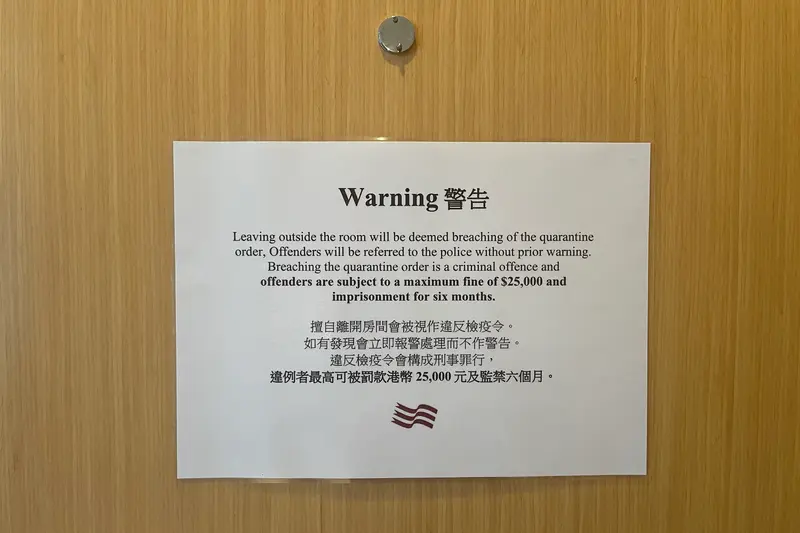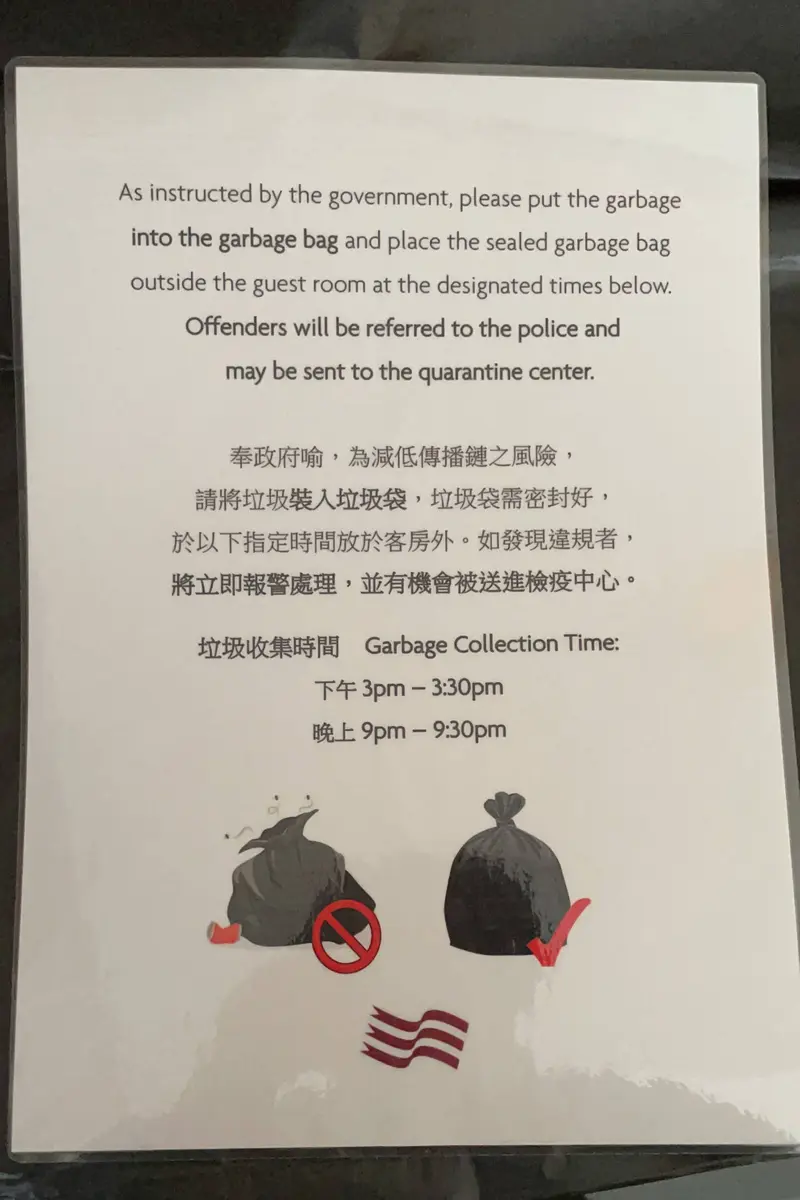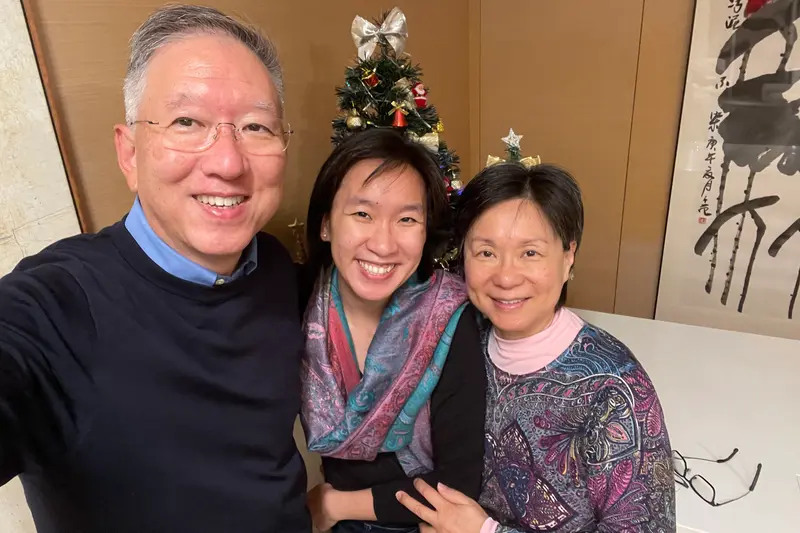As I walked off the jet bridge into Hong Kong International Airport, I stepped into another world. I was home for Christmas, to see my parents for the first time in two years. But first, I had to get through a gantlet of COVID-19 precautions that envelop the city like a protective bubble.
Incoming travelers were greeted by gowned, gloved and masked workers, who directed us through the terminal. As I followed the passengers ahead of me, I was unnerved by the shuttered stores. Every other time I’ve flown in and out of Hong Kong, the airport hums with thousands of travelers, children scampering across the polished floors, announcements intoned in English, Cantonese and Mandarin. The terminal was now eerily still. My feet made too much noise as I trudged along the path marked by guardrails.
A PPE-covered worker sent me to a series of stations. First, I pulled my mask down for a nurse to swab my nose and throat for a PCR test. Then I presented my documents — preflight negative COVID-19 test, proof of hotel booking, Hong Kong resident ID and vaccination card — to an officer who scrutinized them before declaring me up to par. The worker at the next station checked for a functioning phone, test-dialing my U.S. number. Then I was presented with a sandwich and water bottle and directed to a waiting area with chairs and desks placed in a grid as though ready for an exam. I checked my lanyard to find my seat: G205.
As I waited for my COVID-19 test results, I could see the sky through the arched windows turning bright, revealing a beautiful, cloudless December morning. I texted my parents: “Landed!” They responded with clapping emoji. I would see them in 21 days.
Sitting in the cavernous space, I suddenly felt so far from the previous day, when I checked on the chard and radishes growing in my California garden and took a walk with my friend and her new puppy. For all the caution I had taken to reduce exposure in the interminable months since March 2020, that all felt like child’s play compared with the Compulsory Quarantine Order in my hand, which reminded me that I, Chen Caroline Yi Ling, was required, with immediate effect, to be quarantined in my hotel room at the Crowne Plaza as ordered by Yau Yuet-ming Lannon, an authorized officer of the Regulation, until Dec. 20, 2021, at 11:59 p.m. I flipped through the booklet of instructions for the three weeks of hotel quarantine. On Page 4, bold letters declared: “Warning: Leaving the room will be treated as breaching of the quarantine order. Offenders will be referred to the police without prior warning. Breaching the quarantine order is a criminal offence and offenders are subject to a maximum fine of HK $25,000 and imprisonment for six months.”
It felt like a different planet.
Hong Kong’s quarantine procedures are among the strictest in the world. The city is committed to a “zero-COVID” policy, which means it will take every possible measure to prevent a single case. Its policies for travelers have become progressively stringent. In December 2020, concerned about the B.1.1.7 (alpha) variant, the government increased the quarantine period for travelers from the United Kingdom to 21 days “so as to ensure that no case would slip through the net even under very exceptional cases where the incubation period of the virus is longer than 14 days.” Concerned about the delta variant, 15 countries including the U.S. were added to the “high-risk” category in August of last year, even though local scientists said the additional week was unnecessary and extreme. As it turns out, I arrived just before another change: With the emergence of the omicron variant, travelers from the United States were required to spend four days in government quarantine facilities — spartan temporary housing in an isolated corner of one of Hong Kong’s islands — before being released to a hotel of their choice for the remaining 17 days.
I was spared that fate, thankfully. Once my airport test registered negative, I was released to a shuttle that dropped me off at my hotel. A PPE-shrouded employee sent me up the service elevator to my room on the 21st floor. It would be my home for the next three weeks.

“Are you still sane???” “How are you surviving??” my U.S. friends texted me. The honest answer was, “It’s fine!” The ability to work remotely filled my days, and large windows with a beautiful view helped to ward off claustrophobia. The meals that appeared at my door were sufficient if not inspiring. I came to appreciate YouTube exercise videos and little luxuries at the hotel, like the hot water kettle that I used to make endless cups of tea and the laundry line over the bathtub. Deliveries were allowed, and my parents dropped off a yoga mat and fresh fruit. One of my childhood best friends sent me home-baked goods. These gifts, each heralded by a doorbell ring, were doses of love that buoyed my spirits. I made my way through seven and a half books and refreshed my rusty Cantonese by watching local TV stations.
Watching the nightly news, I was struck by the detailed reports on every COVID-19 case: countries visited, timelines of infection, recountings of symptoms and sequencing details. This is only possible because there are so few cases. During the first week of my stay, the city, which has a population and land area similar to that of New York City, had an average of four daily cases, all of which were caught in travelers during the quarantine process. When the first omicron cases were detected, a case study dissected how one traveler managed to infect another residing across the hallway at the same hotel — even though they never had their doors open at the same time. The virus must have managed to linger in the hallway, transmitted while they were reaching out to grab their meals. The case study provided the world with an early hint as to just how transmissible the new variant could be.
Every three days, I had my only human contact. The doorbell would ring, I’d open it to an HVAC tube like an enormous vacuum hose held in front of my face while a PPE-clad worker swabbed my nose and throat. In the course of the hotel stay, I was tested seven times, including two samples collected the day before departure, which were sent to separate laboratories, just in case one provided a false negative. Even the trash was tightly regulated: I was instructed to put garbage in a sealed bag outside my room at designated times — otherwise, a sign warned me, I could be referred to the police and sent to a quarantine center. I have never in my life been so attentive about handling garbage.

I can’t say Hong Kong’s approach to COVID-19 is better or worse than other countries’ policies. Twenty-one days of quarantine is excessive. Experts have said that the zero-infection policy is unsustainable, and it is fair to be concerned about the impact to the city’s reputation as an international commerce hub. Even local residents have pushed back at times, such as when 120 schoolchildren were sent to government quarantine facilities for three days after a parent tested positive. Arguably, improving the local vaccination rate (currently at 69% with two doses) could pave the way for easing some policies, but in an unexpected chicken-and-egg scenario, the lack of COVID-19 cases is one reason why many residents have put off getting their shots.
Whether or not the strict measures are ideal, the result is undeniable: When I finally departed my hotel, there were zero cases of COVID-19 in the city. Life is remarkably different than in the U.S.
I celebrated Christmas with my extended family: more than 20 of us together, from my grandmother and my cousin’s infant children, and we were spared fraught discussions of testing and exposure and risk reduction that so many U.S. families wrestled with this year. I walked through shopping malls and rode subway trains packed with people, knowing I didn’t have to worry about exposure. One of my best friends, currently pregnant, said she’s grateful to feel safe.
Everyone wears a mask, both indoors and outdoors. Stores on every other street corner tout rainbow displays of surgical masks, with a dazzling variety of patterns. Christmas-themed masks were popular over the holidays. I made a game of trying to spot people not wearing masks and only managed to catch one person wearing their mask under their nose. Otherwise, compliance was universal. I debated the extensive masking with my mom: If there’s no local transmission, why would anyone need to wear a mask, particularly outdoors? Masking is a shared community responsibility, my mother replied. She observed that Hong Kong is an incredibly dense city and added that, when the omicron variant inevitably reached Hong Kong, universal masking would help to slow its spread.
Sure enough, my mom was right. There are loopholes in Hong Kong’s COVID-19 containment policies. Local aircrew members were allowed to serve a weeklong quarantine at home, a concession to the grueling mental health effects and impracticality of losing staff to weeks of hotel quarantine every time they returned. Crew members could also leave their homes for essentials like grocery shopping and mandatory COVID-19 testing.
The day before I left Hong Kong, my flight was abruptly canceled. A Cathay Pacific crew member had violated the rules. He left home quarantine early on Dec. 27 and ate at a restaurant in a shopping mall. When he tested positive a few days later, an intense contact tracing effort began. As of Jan. 3, health authorities had identified five other positive cases related to the restaurant. After nearly three months of zero cases within the city, Hong Kong had local transmission again. Health authorities have sent 200 diners and 22 restaurant employees to government quarantine facilities, using credit card transactions to track down the customers. A few days later, after discovering a positive case that was “untraceable” to other known cases, the government said it would stop flights from several countries for two weeks and imposed a curfew on restaurants, banning meals after 6 p.m.
The immediate and overwhelming response to a handful of cases means that local transmission likely will not explode. But it comes at a cost. The government immediately tightened quarantine rules for aircrew members, requiring hotel stays for up to 14 days. Cathay, already struggling with staff quitting over increasingly strict measures, canceled numerous flights, unable to book enough hotel rooms to satisfy the new requirements.
Over the past two years, much comparison has been made between different countries’ COVID-19 policies. I have heard so many times, “Why can’t the U.S. be like X country?” Having experienced a drastically different approach from the United States, I have more respect for the trade-offs inherent in every choice. Hong Kong has been incredibly successful in battling the virus, with about 12,700 cases and 213 deaths out of a population of 7.5 million to date (compare that with New York City’s 1.7 million cases and 35,500 deaths among 8.4 million residents.) The community-minded and prevention-oriented attitude of Hong Kong citizens is one that Americans could benefit from. Yet Hong Kong is losing talent and business due to its strict approach (coupled with recent political changes such as the sweeping national security law passed in June 2020). It’s unclear if a zero-infection policy can be sustained as Hong Kong moves to open its borders with mainland China, and I wonder how the city will adapt as the virus becomes endemic.
But what I’d like to hold on to, after traveling between these two worlds, is the reminder not to take things for granted. The small things, like the ability to cook my own food and exercise outdoors. The bigger things, like being able to walk through a bustling crowd without anxiety.
And the most important thing: being able to see my loved ones, with or without the hassle of quarantine. I was technically free to leave the hotel at midnight, but I suggested to my parents that I check out the next morning so they wouldn’t have to stay up. “We will be unable to sleep knowing that you can be at home that very moment,” my dad responded, insisting that they would be there at 12 a.m. So I sat in my hotel room, watching the clock and waiting for the knock on the door that meant I was free to go. Then I stepped out into the cool night and walked into my parents’ waiting arms.
